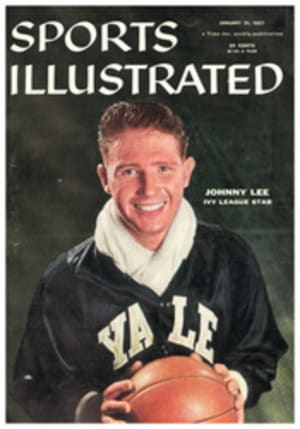
THE COMMODORE OF BIMINI
As far as the eye can see, a white beach curves like a shimmering scimitar, cutting a path between land and sea. Offshore, riding gently on the flat-calm, gin-clear waters, a cruiser lies waiting, rigged and ready for the call to the Gulf Stream and the business of battling marlin and tuna. Above the quiet beach an azure pool basks in the tropic sun, and paved walks wander between palms and bougainvillaea on the dunes. This is Paradise Point, on the island of Bimini, where a man tanned to the color of leather and alive with the energy that built a place most men can only dream of sits at a chessboard and raises his glass in a toast to a life that is extraordinarily good.
George Albert Lyon, the inventor of early automobile bumpers, big-game fisherman, skin-diver, astronomer, chess addict and one of the best men with a slingshot who ever drew a bead, is known as "The Commodore" on Bimini, as admired by his many guests as he is beloved by the natives. Now 75, he is, without doubt, one of the nation's most remarkable sportsmen. He is also, according to his friends (who include some of the country's most prominent men of government and business), a remarkable host. To be entertained at Paradise Point, which he built on Bimini several years ago, is an unforgettable experience—and until you get used to it, an exhausting one. For keeping up with the Commodore as he tears through a normal day is a sporting marathon that few city-bred constitutions are able to take.
Guests find a typical day can begin in the predawn darkness with the Commodore rousing the house to come look at a favorite star through his telescope on the roof. A swim in the pool or sea may follow, and after breakfast the day really gets under way. The morning may be taken up with deep sea fishing for giant tuna or blue marlin; or a skin-diving expedition, led by the Commodore, to the wrecks around the reefs and an hour of water skiing; and always a continuous chess game aboard either of the two fishing cruisers which act as floating bases for the day's sports.
After a lunch aboard of cold cuts and beer the party puts back to the main house, transfers to skiffs and goes bonefishing on the flats. The Commodore, a powerhouse of energy at all times, is even more driven in the matter of bonefishing. Some years ago a golfer named Sammy Snead dropped a line off Paradise Point and within 10 minutes hooked a record-breaking 15-pound bonefish. The biggest the Commodore has ever caught in 35 years of bonefishing is 11 pounds.
Should bonefishing be slow, guests can spend the rest of the afternoon harpooning sharks from a skiff. By the time evening cocktails are served (on a pine-needle-covered patio overlooking the pounding surf), the uninitiated guest might think that the moment for relaxation has at last arrived. Not so. With the drinks comes a trayful of slingshots, bags of steel balls for ammunition and an introduction to another of the Commodore's sports—picking off crabs from the rocks below.
Dinner is usually a sumptuous barbecued affair served to perfection on the west terrace. Things do relax a bit at this point; or at least they take a sedentary turn. In the evening the Commodore likes to take on all comers at chess (playing two games at a time) or show some of his incredibly beautiful underwater films (photographed by Ralph Bowden, the manager of Paradise Point). For those who are willing to try it, however, he is perfectly prepared to stage a midnight roller-skating jamboree around the second-floor balcony. Skates and boots to fit all sizes, male and female, are, like the slingshots, a permanent part of the Commodore's sporting equipment.
Because of his diverse and sometimes decidedly extraordinary sporting activities, Bert Lyon is at times mistaken for an eccentric. "The fact is," says Van Campen Heilner, a longtime friend of the Commodore and an author and sportsman in his own right, "Bert has a phenomenal lust for living and the guts to do what he enjoys doing—regardless of what anybody else thinks. He has a puckish sense of humor. He is an outrageous practical joker and will try anything once. For instance-he was 69 when he decided to take up skiing. First, he studied all the movies he could find on the European champions. Then he had himself pulled on skis all over the estate, sliding on the pine needles. When he thought he was ready he went up to Michigan, broke his leg the first time out and was flown back to Bimini in a cast."
Today Bert Lyon is chairman of the board of Lyon, Inc., largest users of stainless steel in the world (over 30 million pounds in 1955). Among other things, his company manufactures wheel covers for the entire automobile industry, equipping between 4 and 5 million vehicles annually. Several times he has retired for good, only to be seized with another idea that brings him back into business bigger than ever.
His discovery of the seven-mile-long, 300-yard-wide island of Bimini was made in 1923 in the company of his friends Harry Stelwagon of Philadelphia and Sam Adams, the joke maker of Asbury Park, New Jersey. Van Campen Heilner had a fishing camp on the sland in those days, and the four would fish there every year.
When he first went to Bimini, Bert Lyon had just perfected his automobile bumper and was playing around with many more ideas. He found the primitive island's atmosphere restful, and he particularly liked to sit for hours on a rock at Paradise Point (then British Crown land) working out the problems of his inventions. It was his dream to one day own this piece of land and build there a perfect, self-sufficient private world in which to work and relax.
As his inventions succeeded, his dream grew in proportion. He developed a metal tire cover for spare wheels; produced plastic and metal white walls; stainless wheel-trim rings (100,000 a day); and the stainless steel wheel cover. And finally he did acquire the Paradise Point land and built there in 1935 his first Bimini house, the Casa de Lyon. There were few trees on the island then, so he planted thousands of Australian pines and coconut palms.
Concerned about the lack of medical facilities on the island, the Commodore tried to build a hospital. When this bogged down in red tape he started out on a clean-up campaign, enticing the natives to his movies on hygiene with free ice cream.
The Commodore's coming has also greatly stimulated the island's economy. He gives generously to many Bahamian charities. Through him, more and more fishermen have been introduced to Bimini waters, bringing with them jobs and money for the natives. With his son George A. Lyon Jr. he sponsored the Bimini boxer Yama Bahama and is largely responsible for his ring success. In recognition of his work for Bimini the Queen has made Bert Lyon an honorary Commander of the Order of the British Empire.
But as more and more of his friends and associates came to Bimini to share the Commodore's fun, it became obvious that Casa de Lyon was too small. To the utter disbelief of many of his friends he embarked in 1951 on the final phase of his lifetime dream—the building of a million-dollar work and relaxation plant.
Today it rises up out of the rock of Paradise Point, a three-story reinforced concrete edifice of South American modern design. Surrounding the main building, which has five bedrooms, an elevator and a suite on the third floor, are 1,000 acres of privately owned land, including three and a half miles of beach.
In a completely equipped machine shop and laboratory nearby, the Commodore continues to work and carry on experiments, flying his Detroit engineers down to Bimini in a Grumman Mallard plane for consultation.
As it now stands, Paradise Point has its own power plant, telephone system, laundry, a million-gallon water catchment and a staff of 30. Come hurricane, high water or drought, this unique establishment is equipped to survive.
"The place is so popular, in fact," the Commodore's son George, who is president of the company, said recently, "that we may have to turn it into a private club to take care of all the guests who want to come."
PHOTO
JOHN G. ZIMMERMAN
BUBBLING AND BEAMING, BERT LYON TOASTS CHESS MOVE
PHOTO
JOHN G. ZIMMERMAN
FROM THE ROOFTOP OF THE THREE-STORIED SOUTH AMERICAN MODERN STYLE MAIN HOUSE, SPORTSMAN LYON LOOKS DOWN ON THIS BREATHTAKING VIEW OF HIS DOMAIN
PHOTO
JOHN G. ZIMMERMAN
GRACEFULLY THE COMMODORE ZIPS AROUND A CORNER ON HIS FAVORITE WHEELS, FOLLOWED BY ELIZABETH JOHNSON
PHOTO
JOHN G. ZIMMERMAN
IN WORKSHOP, adorned with the wheel covers he makes, Commodore tries out ideas.

